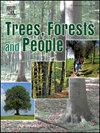Impact of forest fires on vegetation composition and soil properties of Pinus roxburghii forests in the Western Himalaya
IF 2.7
Q1 FORESTRY
引用次数: 0
Abstract
Fire is a commom phenomenon in the Western Himalaya, particularly in the Pinus roxburghii (Chir Pine) forests. The frequent incidence of devastating fire events in these forests can result in serious ecological consequences, such as loss of biodiversity, changes in vegetation composition, and alterations in soil properties. Therefore, the current investigation was conducted to assess the impact of wildfires on the composition, species richness, dominance, and diversity of vegetation, as well as soil properties, in the P. roxburghii forests of the Western Himalaya. The findings indicated that the fire led to an increase (p<0.05) in the shrub species. On the contrary, the total number of tree species seedlings and herb species remained unchanged after the fire event. Further, results showed that the two pre-existing shrub species disappeared, and the three new species of shrubs emerged after the fire. Likewise, fire led to the emergence of five new herb species, while five pre-existing herb species disappeared. The overall seedling density of shrubs, herbs, and trees exhibited an increasing (p<0.05) trend in the post-fire scenario. Interestingly, the density and frequency of P. roxburghii trees were almost same both before and after the fire. The density and frequency of Berberis asiatica, Lantana camara, and Rhus parviflora shrubs increased following the fire, while Rubus ellipticus shrub exhibited a declining trend. Furthermore, in the post-fire conditions, the seedling density of P. roxburghii and Myrica esculenta trees increased (p<0.05), while the density of Quercus leucotrichophora decreased (p<0.05). Similarly, the density of Rumex hastatus and Oxalis latifolia herbs increased, while that of Desmodium elegans and Parthenium hysterophorus herbs decreased in the post-fire scenario. Among the different species, P. roxburghii (tree), L. camara (shrub), and P. hysterophorus (herb), were the most prevalent in both the pre- and post-fire scenarios. The diversity and abundance of tree seedlings decreased, shrubs increased, and the diversity of herbs remained unaffected in post-fire scenarios. The results further showed that the forest fire increased the soil pH, EC, and nitrogen levels, although organic carbon and potassium content decreased. Moreover, fire did not alter the levels of bulk density, phosphorus, and sulphur in the soil. Overall present study suggested that fire affects structure and composition of vegetation as well as alters soil properties in the Pinus roxburghii forests.
森林火灾对西喜马拉雅刺梨松林植被组成和土壤性质的影响
在西喜马拉雅地区,火灾是一种常见的现象,尤其是在红松林。这些森林频繁发生的毁灭性火灾会造成严重的生态后果,如生物多样性的丧失、植被组成的变化和土壤性质的改变。因此,本研究旨在评估山火对西喜马拉雅刺梨森林植被组成、物种丰富度、优势度、多样性和土壤性质的影响。结果表明:火灾导致灌木种类增加(p < 0.05);与之相反的是,火灾发生后树木种苗总数和草本种苗总数没有变化。结果表明,火灾发生后,原有的2种灌木消失,3种新灌木出现。同样,火导致了五种新的草本植物的出现,而五种原有的草本植物消失了。灌木林、草本植物和乔木幼苗密度总体呈增加趋势(p < 0.05)。有趣的是,在火灾前后,刺梨树的密度和频率几乎相同。小檗、山楂和小黄树灌木的密度和频次在火灾发生后呈上升趋势,而红莓灌木呈下降趋势。此外,在火灾后条件下,刺梨和杨梅的幼苗密度增加(p<0.05),而白骨栎的密度减少(p<0.05)。同样地,在火灾后的情景中,有毛缕草和草叶草的密度增加,而蜜缕草和宫草的密度减少。在不同的树种中,在火灾发生前和火灾发生后的情景中,最常见的是树(P. roxburghii)、灌木(L. camara)和草本(P. hysterophorus)。火灾后,乔木幼苗的多样性和丰度下降,灌木增加,草本植物多样性未受影响。结果进一步表明,森林火灾增加了土壤pH、EC和氮含量,但降低了有机碳和钾含量。此外,火并没有改变土壤中的体积密度、磷和硫的含量。研究表明,火灾影响了刺梨松林植被的结构和组成,并改变了土壤性质。
本文章由计算机程序翻译,如有差异,请以英文原文为准。
求助全文
约1分钟内获得全文
求助全文
来源期刊

Trees, Forests and People
Economics, Econometrics and Finance-Economics, Econometrics and Finance (miscellaneous)
CiteScore
4.30
自引率
7.40%
发文量
172
审稿时长
56 days
 求助内容:
求助内容: 应助结果提醒方式:
应助结果提醒方式:


